The approximate geographical locations of where the coins were issued can be seen on this map
(identify coins by their coin numbers). Coins of large empires are located in the area of the presumed capital cities.

|
|
|
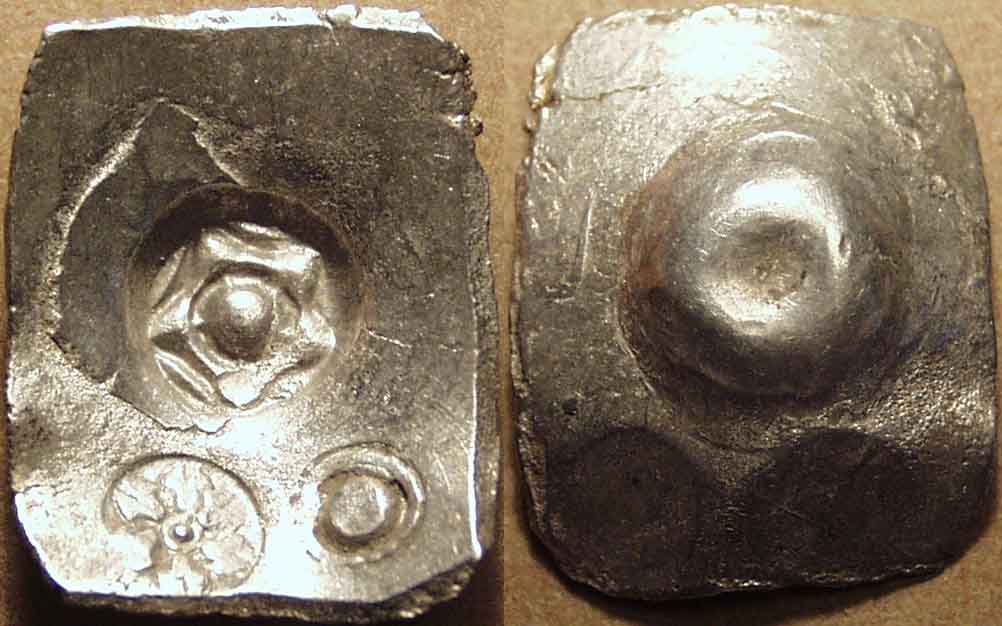
|
Coin #1:
Shakya janapada, Silver 5-shana, c. 5th century BCE
Pentagonal punch plus two banker's marks / Blank
Weight: 6.96 gm., Dim: 24 x 32 mm. |
|
Around 500 BCE, India was divided up into many separate "countries." Buddhist sources identify 16 major janapadas, or tribal
territories. Coinage commenced at around
this time and two of the earliest janapadas to issue coins were Gandhara, in the north-west (now northern Pakistan), and Shakya, along the India-Nepal borderlands. This
coin is an issue of the Shakya janapada. This janapada is of particular interest as it was the birthplace of the Shakya prince Siddhartha Gautama, who became the
Buddha. It is quite likely that the Shakya coin comes from approximately the same time and place as the Buddha.
The Shakya coin is an example of a coin type that was invented in India and continued to be used for over 1500 years: the punch-marked coinage. The name reflects the
technique of manufacture used. The coin blanks were prepared usually by cutting large sheets of silver, and were then "punched" by one or more small punches that modeled
specific designs. We see in the Shakya coin all of these ingredients. The rectangular shape reflects the easy cutting of the coin blank from a larger sheet, the sharp edges
betray their origin from the use of a chisel, and the central punch reflects the core design of the coin, here the so-called "pentagonal symbol." The violence of the punch is
expressed in the protuberance seen on the otherwise blank reverse. Some coins are found with only the one central punch, while others are found with additional punches
around the central one. Some of these may have been official punches, and some may have been so-called "banker's marks," punches applied by bankers or money-changers,
presumably to record their having assayed the metal content of the coin and found it be of sufficient purity. On this coin, there are two additional punches. One is a simple
punch of a pellet and circle, probably a banker's mark, while the other is a complex symbol with a central dot surrounded by six arrowheads arranged radially. This may well have
been an official punch, for three reasons: first, it is more complex than the typical banker's marks, second, it appears with some frequency on the Shakya coins, and third, it
seems to be a precursor to the so-called "six-arm" symbol that appeared on virtually all the coins of the Magadha-Maurya dynasty of the 4th through 2nd centuries BCE. We will
see one such coin a little later (coin #3).
For more Shakya coins, see the Shakya gallery.
|
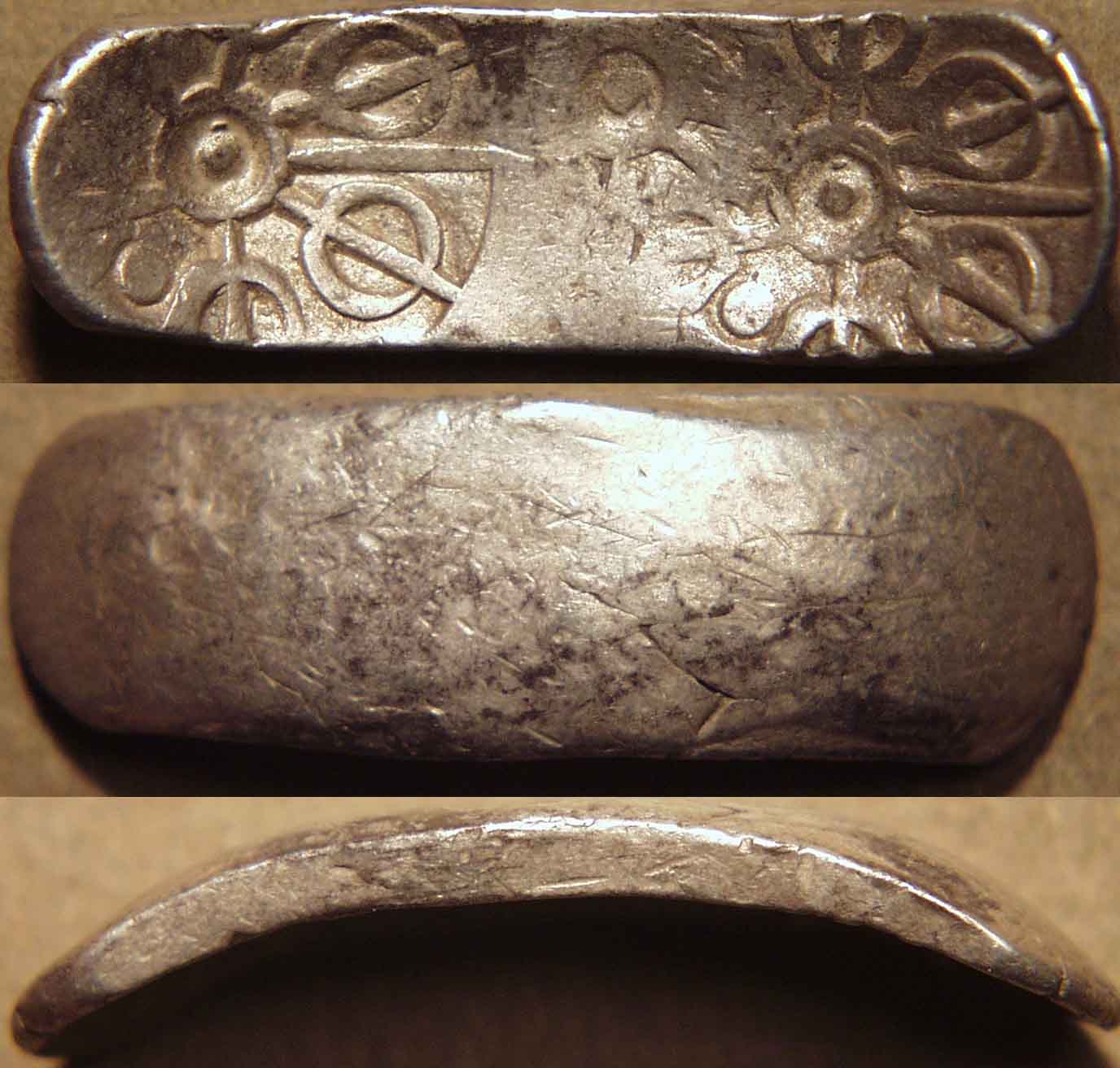
|
Coin #2:
Gandhara janapada, Silver satamana, c. 5th-4th century BCE
Three "septa-radiate" punches/Blank
Weight: 11.46 gm., Dim: 43 x 22 mm. |
|
Coin #2 is a silver satamana of approximately 11.5 gm. from the Gandhara janapada, also dating from some time late in the 5th or from
the 4th century BCE. This type is called a
"bent bar" to reflect its ingot-like shape, curved into a crescent by the force of the two punches applied to its ends. The punches are produced by the same die. Most coins
have just two punches, one at each end, but I have seen a few rare ones, such as the illustrated coin, that have a third punch in the center of the bar. The punches are always
of this "septa-radiate" symbol, six "petals" radiating from a central circle accompanied by a seventh "stem."
This coin type has been used by some writers, notably Joe Cribb of the British Museum, to serve as evidence that coinage was not invented independently in India, but rather
was derived from Greek sources. There exist some very rare coins of Kyrene that feature a design, probably representing a silphium flower, that resembles the punches on the
Gandharan bent bars. Further, it is known that the Achaemenids, who ruled the Gandharan region in the 5th - 4th century BCE, resettled some political “trouble-makers” from
Kyrene somewhere in their Indian satrapy. It has therefore been suggested that these Greeks from Kyrene brought with them the idea of coin-making from which the Gandharan
bent bar resulted. In this view, these bent bars would not be issues of the Gandhara janapada but rather of the Achaemenid satrapy of India.
Most Indian numismatists do not accept this view, and I personally feel that the Gandharan coins offer evidence precisely of the opposite conjecture, that coinage was invented
independently in India. The reason is that they are completely unlike any coins that circulated in Persia, such as the running king type, obviously
inspired by Greek coins. Nor do they resemble the Kyrene coins in shape or method of manufacture. For coins so radically different from the Greek or Persian style coinage to
circulate in a satrapy of the Persian empire, it must have been the case that they already had a history of commercial use in the area. The Persians must have discovered, as
did the Greeks after them, that Indian merchants did not take easily to new styles of coinage; they liked to stick with tried and true designs with which they were familiar.
For more Gandhara coins, see the Gandhara gallery.
|
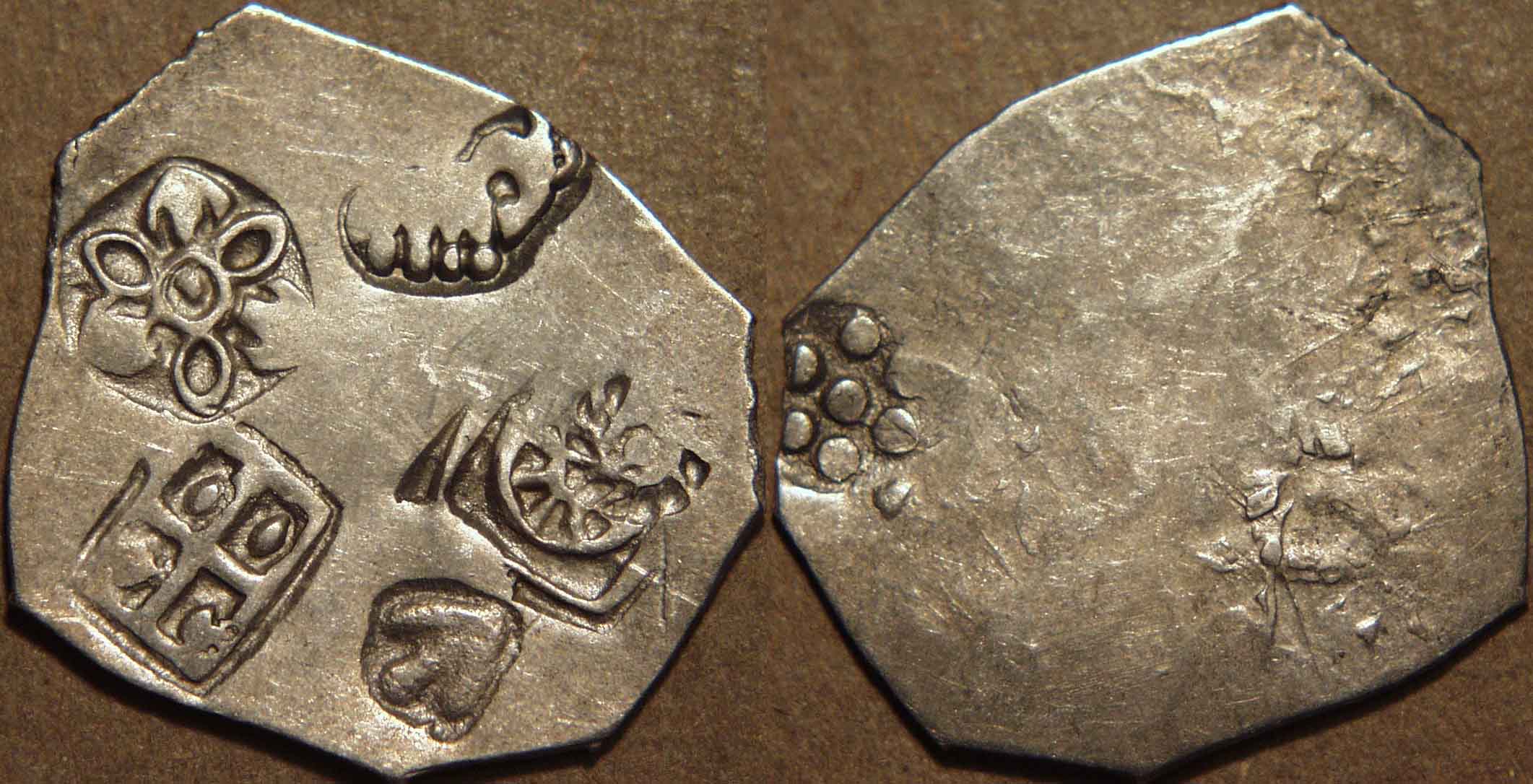
|
Coin #3:
Magadha janapada, Silver karshapana, c. 4th century BCE
Weight: 3.45 gm., Dim: 25 x 23 mm.
Five punches: sun, 6-arm, and three others / Banker's mark
Ref: GH 48.
 |
|
Coin 3 is an issue of yet another janapada: Magadha, perhaps the most important of the 16 janapadas. It was centered in what is now
the Indian state of Bihar, just south of Shakya. It was here that Siddhartha Gautama roamed as a seeker after renouncing his worldly comforts; it was in the Magadhan city of
Gaya that he attained his enlightenment, and it was mainly here that he preached the dharma for the remainder of his life. The Magadhan king Bimbisara was a friend of
Gautama and even offered him his throne. This
coin may well have been an issue of Bimbisara, although we are not able to attribute specific types to specific kings because of the lack of any inscriptions on the coins.
Magadha was the most successful of the old tribal kingdoms, as it expanded slowly but steadily, eventually growing into the first Indian empire under the Mauryan kings.
The Magadha coin is a silver karshapana of just under 3.5 gm. It shows that punch-marked coinage evolved from the original single-punch type (as on the Shakya coin above
and on very rare early Magadha coins) to multiple punch types. After a stage during which the coins featured four punches, the designs seemed to settle on a standard of five
punches, a standard that persisted for a couple of centuries. We do not know the significance of the punches. An intriguing sentence in an ancient Buddhist text, the
Visuddhimagga, says that, by looking at a coin, a money-changer would at once know from what village, town, city, mountain or river bank and by what mint master it was
struck. This suggests that the punches did indicate the origin of the coin, but unfortunately we have not yet learned the code.
What we do know is that, for a long period of time, the punchmark coins of the Magadha (later the Maurya) empire carried five punches. One was consistently a radiate solar
disc, here seen somewhat obscured within a second punch (the wheel in square). A second was one of the six-arm symbols, referred to above in our discussion of the Shakya
coin, and seen here in a form containing three arrowheads and three ellipses that may have represented petals or leaves. The other three punches varied. Here we have what
might be a Buddhist dharmachakra, or sacred wheel, a rectangular punch which looks something like a window, and an elephant, also often used as a Buddhist symbol. The
punch that looks like an arrowhead is not an official punch, but a banker's mark. Other common official symbols include the bull and other animals, various geometric figures,
including a 6-pointed star similar to the Star of David, and occasionally human figures. This coin also carries two banker's marks: the arrowhead on the obverse and a rosette of
seven pellets on the reverse.
For more Magadha coins, see the Magadha gallery.
|

|
Coin #4:
Bactria, Seleucid, Seleucos I Silver tetradrachm, c. 290 BCE
Weight: 16.87 gm., Diam: 26 mm.
Laureate, bearded bust of Zeus right / Athena driving elephant quadriga
Greek legend: BAΣIΛEΩΣ ΣEΛEYKOY (of King Seleucos)
Ref: MIG 52 |
|
Coin 4 represents one of the first clearly "foreign" coins to be minted in India. Although the Achaemenids had ruled northwestern India
for a while, they did not leave any numismatic legacy. However, after Alexander the Great's brief appearance on the Indian horizon, the Seleucid empire established a presence
in the northwestern part of the country. Although a few Greek style coins were minted in Bactria prior to the Seleucid issues, this coin, of Seleucos I (312-280 BCE) is
nevertheless one of the first Greco-Bactrian coins. With a laureate head of Zeus right on the obverse and Athena in an elephant quadriga on the reverse, the coin is
representative of the highest quality classic Greek coins of the period. It introduces to Indian numismatics not only an entirely new design type, but also the use of legends to
identify the issuer. Here we see on the reverse the Greek inscription: BAΣIΛEΩΣ ΣEΛEYKOY (of King Seleucos).
To Seleucos, the Indian provinces were a distant holding far from the center of his empire in Syria. These distant provinces faced a threat from a rising super-power in India: the
Maurya dynasty. The dynasty was founded in 322 BCE by Chandragupta Maurya, who overthrew the Nanda rulers of the Magadha kingdom and then began a process of
expansion that extended the empire all the way to what is now Pakistan. Facing conflict with this powerful rival, Seleucos chose to forge a peace. He conceded all the
Seleucid lands south of the Hindu Kush mountains (in modern Afghanistan) to Chandragupta (known as Sandracottas in the Greek literature of the time) in exchange for 500
elephants. So the Mauryan empire now extended from Bengal in the east all the way to Afghanistan in the west.
The Mauryan empire reached the peak of its extent probably under the rule of Chandragupta's grandson Ashoka (273-232 BCE), who has been called the greatest king the
world has ever known. Ashoka's claim to this distinction comes from an unlikely source: It stems not from the extent to which he expanded his empire through conquest, but
rather on his renunciation of violence and war, his adoption of Buddhism, and his mission to spread the non-violent teachings of the Buddha throughout his empire. Ashoka
carved the Buddha's teachings on rocks throughout India, or on iron pillars he erected for the purpose. He also sent Buddhist missions to other countries, notably to Lanka,
China and Southeast Asia. There is little doubt that he was the person who did more than anyone else to spread Buddhism throughout Asia.
For more coins of Seleucos I, see the Seleucos I gallery.
|
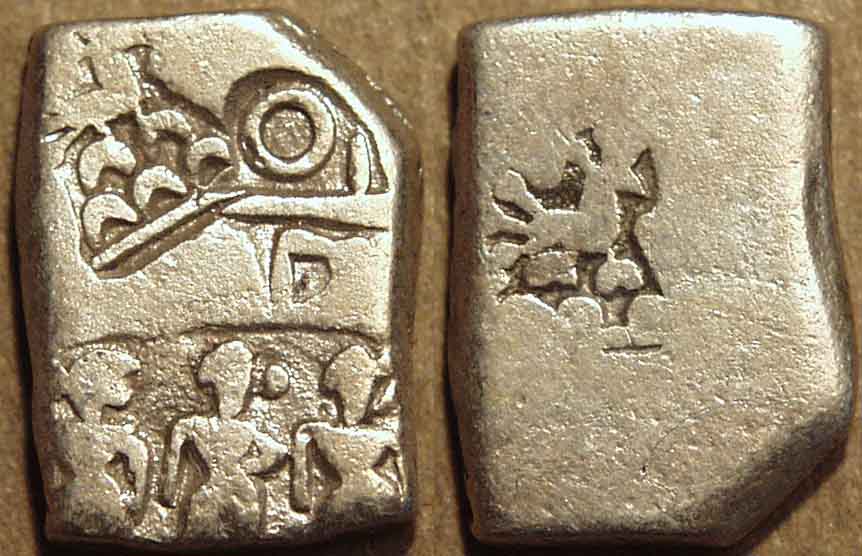
|
Coin #5:
Mauryan Empire, perhaps Ashoka the Great (273-232 BCE), Silver karshapana
Weight: 2.96 gm., Dim: 10 x 15 mm.
Three punches (three deities, peacock on hill, "steelyard" / Single punch (peacock on hill)
Ref: GH 591
 |
|
Coin 5 is a silver karshapana of the Maurya dynasty. Unfortunately, we do not have a definitive way to attribute these coins to specific
kings, but this coin may well have been
an issue of Ashoka the Great. Most Mauryan coins continued the Magadha pattern of five punches: a sun, a 6-arm symbol, and three others. This coin, however, is a rare
deviant from this general pattern. The sun and 6-arm symbol have been eliminated and there are only three punches, although one is a compound punch with three figures.
(There are other, similar, coins with three separate figure punches very much like the three on this single punch.) The punches include a very interesting one of a peacock
perched on a 5-arch hill, which in all probability was a Buddhist symbol. A smaller version of the same punch appears on the reverse.
Although the Mauryan coins followed the coins of Magadha in many respects: they remained on the same karshapana weight standard, had essentially the same technique of
manufacture and continued the use of five official punches, they differed in one important respect: their flans were a lot smaller. The Magadha coin we saw earlier (coin 3) was
25 x 23 mm; this Mauryan coin is 10 x 15 mm (but thicker). The main theory used to explain this size change over time is that the mint authority wanted to reduce the amount of
space available for potential banker's marks. Some late Magadha coins are absolutely covered with banker's marks, making it difficult to discern the original design of the coin.
It appears that reducing the size of the flan, and adding a miniature official mark on the reverse (as on this coin), did work to reduce and even eliminate the use of banker's
marks.
The Mauryan kingdom must have been very rich as very large hoards of Mauryan silver coins are still found in India. From the collector's point of view, this is a great series, as
the coins are plentiful, there are hundreds of types, and they can be obtained quite inexpensively. The first Indian coin that I purchased in 1998 when I started my collection
was a Mauryan karshapana I bought on eBay. I couldn't believe I had been able to buy a coin perhaps of the time of Ashoka for under $50 (and I now know that I overpaid!).
The Mauryan empire started to weaken soon after Ashoka's death and crumbled by the second century BCE when the Mauryan king was overthrown by his general,
Pushyamitra Sunga, founder of the Sunga dynasty. The Sunga kingdom, however, was quite small and never attained anything like the magnificence of Ashoka's empire, one
of the largest ever known in India.
For more Maurya coins, see the Maurya gallery.
|

|
Coin #6:
Bactrian Kingdom, Diodotos I or II, Gold stater, c. 250-230 BCE
Weight: 8.24 gm., Diam: 18 mm.
Diademed head of Dioddotos right, dotted border around /
Nude Zeus standing left, seen from behind, holding aegis on left arm, hurling thunderbolt with right
Eagle at left, Greek legend, at right: BAΣIΛEΩΣ, at left: ΔIOΔOTOY
Ref: MIG 70, Bop 5 |
|
While the Mauryans were expanding their empire from Afghanistan to Bengal and from the Himalayas to almost the very tip of the
Indian peninsula, the Seleucids had retained their foothold in Bactria, north of the Hindu Kush mountains. However, around 250 BCE, the Seleucid governor in Bactria,
Diodotos, revolted and declared himself independent. The evidence for that declaration is
seen in his coins ... he began to issue coins, still in the name of the Seleucid emperor Antiochos II, but bearing the image of his chosen deity, Zeus, on the reverse, rather than
Antiochos's choice of Apollo. (You can see such a coin in the Diodotos gallery and some Antiochos I coins issued in Bactria prior to
the revolt in the Antiochos gallery). Further, as evidenced in coin 6, eventually even the pretence of fealty to the Seleucid
emperor was abandoned and Diodotos began to place his own name on his coinage. We see here a wonderful gold stater showing a diademed bust of Diodotos right, with a
"thundering Zeus" left on the reverse and the legend BAΣIΛEΩΣ ΔIOΔOTOY (of King Diodotos).
It shows that the classic Hellenic style of numismatic art had taken a firm foothold in India.
|

|
Coin #7:
Indo-Greek Kingdom, Menander I, Silver tetradrachm, c. 155-130 BCE
Weight: 9.74 gm., Diam: 25 mm.
Diademed, helmeted bust of Menander right, Greek legend around:
BAΣIΛEΩΣ ΣΩTHPOΣ // MENANΔPOY /
Athena Alkidemos standing left, seen from behind, holding aegis on left arm,
hurling thunderbolt with right, monograms at left and right,
Kharoshthi legend around: maharajasa tratarasa // menamdrasa
Ref: MIG 217f, Bop 15 |
|
The Bactrian kingdom established by Diodotos seems to have flourished uninterrupted for about 75 years. However, around 175 BCE,
a scion of the Seleucid family appears to have attempted to overthrow the renegade usurpers. Eucratides (the Great) succeeded to a large extent and established his rule in
Bactria and also south of the Hindu Kush. However, from this time on, it appears the various Greek factions engaged in an almost continuous civil war as rival families
established themselves in different locations and fought one another for supremacy. One king who seems to have reconstituted a large kingdom was Menander. According to
the ancient Buddhist text, the Milindapanha, Menander was a seeker of the Truth who was greatly interested in Buddhist teachings (Milinda is the Pali version of the
name Menander). However, the text of the Milindapanha betrays no Greek influence and Menander's coinage does not contain any Buddhist symbols. Thus it is likely
that the text is apocryphal.
Coin 7 is a silver tetradrachm of Menander on a reduced Indian standard of just over 9 gm. The coin is still very much in the Greek style. We have a diademed, helmeted bust of
the king right on the obverse and Menander's favorite deity, Athena Alkidemos, on the reverse. However, there is an important departure from the previous Bactrian issues such
as the stater of Diodotos we saw earlier. The Greek legend has migrated to the obverse and a new legend, in the local Prakrit language and using the Kharoshthi script, has
appeared on the reverse. The legend: maharajasa tratarasa menamdrasa is a translation of the obverse Greek legend BAΣIΛEΩΣ
ΣΩTHPOΣ MENANΔPOY (of King Menander, the Savior). This coin was issued south of the Hindu Kush mountains and has bowed to the requirements
of the Indian marketplace by adopting the reduced weight standard and introducing a local language legend. Other coins display another concession to Indian tastes: many
Indo-Greek coins are square in shape, particularly the bronze ones, in imitation of the traditional square shape of the silver (and later copper) karshapanas of the Mauryans and
their successors, the Sungas.
|
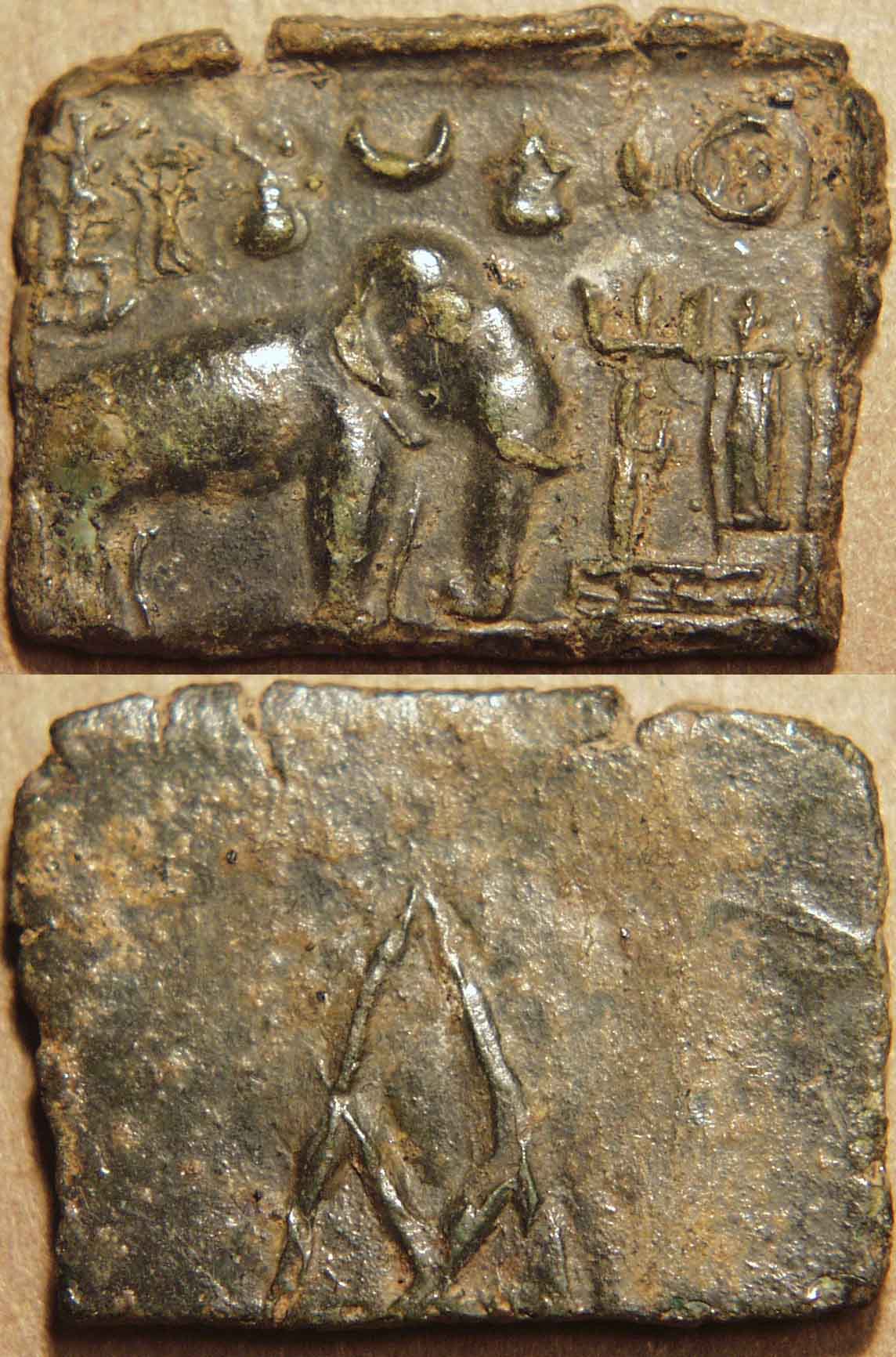
|
Coin #8:
Pandya Kingdom, Sangam period, Anonymous bronze unit, c. 3rd - 1st century BCE
Weight: 7.82 gm., Dim: 29 x 22 mm.
Elephant right, barred trident and altar before, various symbols above /
Stylized fish (Pandya dynastic symbol)
Ref: MAC 4988-95, Krishnamurthy 52-54 |
|
After the collapse of the Mauryan empire around the end of the 3rd century BCE, a number of small kingdoms were established all over India. In southern India, three major
dynasties, the Cheras, the Cholas and the Pandyas, emerged as powerful rulers. This period saw a cultural flowering, particularly of literature in the Tamil language, and has
been called the Sangam age, after the Sangams, or Literary Conventions, that were held at that time. Coin 8 is a magnificent copper issue of the Pandya kingdom from roughly
this time period. It shows an elephant standing right along with a number of symbols on the obverse and a highly stylized fish, the dynastic symbol of the Pandyas, on the reverse.
The artistic standard of the carving is quite high.
The square shape of the coin and the presence of multiple symbols recalls the characteristics of the Mauryan coinage. However, there is an important difference. The symbols
have all been carved on to a single die, which has then been used to strike the coin. Thus the coin is die-struck rather than punchmarked, evidence of Greek influence. The
symbols on the coin seem to be both Hindu and Buddhist. The barred trident in front of the elephant and the crescent moon above seem quite clearly Shaivite, while the railed
tree and the wheel are likely Buddhist in origin. Thus the coin provides some concrete evidence for the theory that the Sangam age was characterized by religious toleration.
|

|
Coin #9:
Panchala Kingdom, Bhumimitra, Copper double karshapana, c. 1st century BCE
Weight: 15.52 gm., Diam: 25 mm.
Deity (Bhumi?) on a pedestal /
Three Panchala symbols, Brahmi legend below: Bhumimitrasa
Ref: MAC 4545 |
|
New kingdoms were emerging on the ruins of the Mauryan empire in northern India also. One such kingdom was Panchala. This had been one of the 16 great mahajanapadas
in the time of the Buddha. Draupadi, one of the central characters of the Hindu epic, the Mahabharata, was reportedly a Panchala princess. This janapada had been absorbed
by Magadha as it pursued its program of expansion. But now this kingdom was reconstituted under the Mitra kings, who issued a most interesting and long-lived series of coins.
Coin 9 is an early Panchala coin of this period, an issue of King Bhumimitra. The Panchala coins all carry the name of the issuing king in Brahmi letters; these are some of the
earliest indigenous Indian coins to carry legends. The illustrated coin carries an image of a deity on the obverse and an incuse punch on the reverse which has the legend
Bhumimitrasa with the three symbols of the Panchala kingdom above. The Panchala series lasted over two centuries, from the mid-2nd century BCE to well into the 1st century
CE.
For more coins of this kingdom, see the Panchala Kingdom gallery.
|
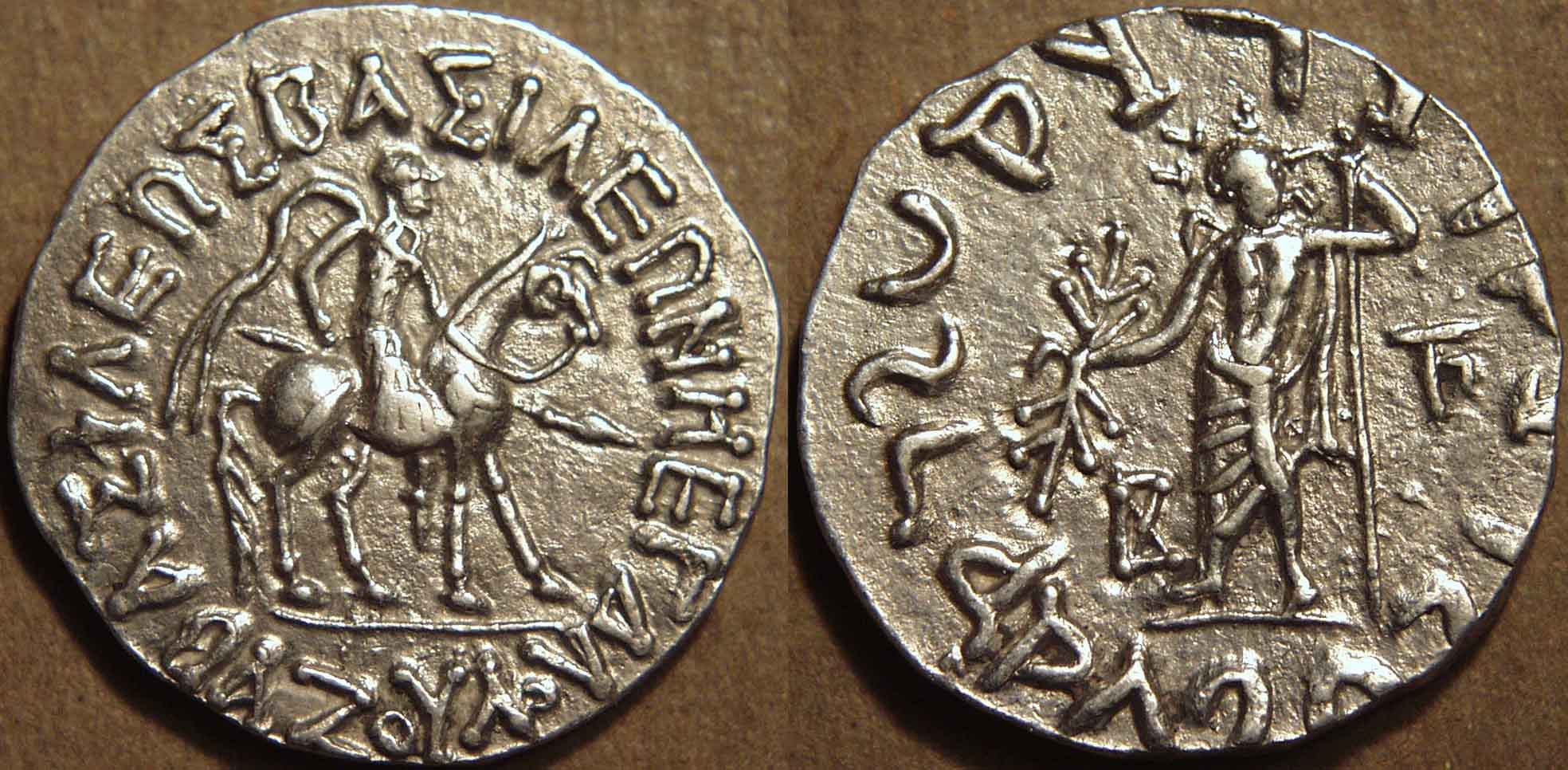
|
Coin #10:
Indo-Scythian Kingdom, Azes I, Silver tetradrachm, c. 1st century BCE
Weight: 9.52 gm., Diam: 26 mm.
King mounted on horse right, holding spear, Greek legend around:
BAΣIΛEΩΣ BAΣIΛEΩN MEΓAΛOY // AZOY /
Zeus standing facing, holding thunderbolt and spear, Kharoshthi legend around:
Maharajasa rajarajasa mahatasa // Ayasa
Ref: MIG 749c, Senior 80.11T |
|
In the north-west, the Indo-Greek kingdom was also crumbling in the face of a powerful new military presence: the Indo-Scythians. These were tribes that had entered India from
a nomadic existence in Central Asia. One of the earliest forays of Scythians seems to have occurred around 150 BCE, when they laid waste to the northern Greek city of
Ai-Khanoum (in the northern part of modern Afghanistan). They seem to have slowly given up their nomadic ways and began to challenge the Indo-Greeks for supremacy in the
area. There is also some evidence that they intermarried with Indo-Greek royalty.
The greatest expansion of the Indo-Scythian realm was made by Azes I. Coin 10 is a silver tetradrachm of this ruler, issued probably in the middle of the 1st century BCE. The
overall design of the coin clearly borrows from the standard Indo-Greek types. There is a portrait of the king on the obverse, circled by a Greek legend, and there is a chosen
deity on the reverse, circled by a Kharoshthi legend. What is different, however, is that the king's portrait is not a bust, but rather a representation of the king mounted on a
horse, dressed in full armor, carrying a spear. The horse must have been an important and potent symbol for a nomadic people and this equestrian portrait recalls the past, even
though the Scythians were now living a settled life. The deity on the reverse is Zeus, holding a large fulmen (or thunderbolt) in his right hand and a scepter in his left; it is
interesting that the Scythian nomads quickly adopted the worship of Greek gods. |
|
|